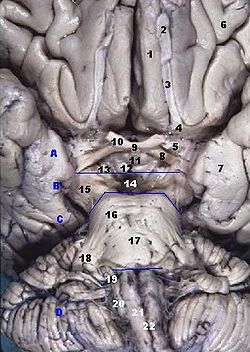- Anterior olfactory nucleus
-
Brain: Anterior olfactory nucleus Human brainstem anterior view (Anterior olfactory nucleus is not labeled, but region is visible at center top, approximately between the "2" and the "3".) Latin nucleus olfactorius anterior NeuroNames hier-262 NeuroLex ID birnlex_1085 The anterior olfactory nucleus (AON; also called the anterior olfactory cortex) is a portion of the forebrain of vertebrates.
It is involved in olfaction.[1]
Contents
Location
The AON is found behind the olfactory bulb and in front of the piriform cortex (laterally) and olfactory tubercle (medially) in a region often referred to as the olfactory peduncle or retrobulbar area. The peduncle contains the AON as well as two other much smaller regions, the tenia tecta (or dorsal hippocampal rudiment) and the dorsal peduncular cortex.
Function
The AON plays a pivotal but relatively poorly understood role in the processing of odor information.
Odors enter the nose (or olfactory rosette in fishes) and interact with the cilia of olfactory receptor neurons. The information is sent via the olfactory nerve (Cranial Nerve I) to the olfactory bulb. After the processing in the bulb the signal is transmitted caudally via the axons of mitral and tufted cells in the lateral olfactory tract. The tract forms on the ventrolateral surface of the brain and passes through the AON, continuing on to run the length of the piriform cortex, while synapsing in both regions. The AON distributes the information to the contralateral olfactory bulb and piriform cortex as well as engaging in reciprocal interactions with the ipsilateral bulb and cortex. Therefore, the AON is positioned to regulate information flow between nearly every region where odor information processing occurs.
Components
The AON is composed of two separate structures:
- a) a thin ring of cells encircling the rostral end of the olfactory peduncle known as “pars externa”,
- b) the large “pars principalis”, seen in coronal sections of most mammalian brains as a two-layered structure.
- The deepest (Layer II) is a thick ring of pyramidal and other-shaped cells surrounding the anterior limb of the anterior commissure.
- The outer, cell-poor layer, is often subdivided into a superficial zone (Layer Ia, which contains the output axons from the olfactory bulb) and a deeper area (Layer Ib).
- Many divide pars principalis on the basis of the ‘compass points,’ yielding pars dorsalis, pars ventralis, pars medialis, pars lateralis, and pars posterioralis (often combined with pars ventralis to form “pars ventroposterioralis”).
References
- ^ Saiz-Sanchez D, Ubeda-Bañon I, de la Rosa-Prieto C, et al. (June 2009). "Somatostatin, tau, and beta-amyloid within the anterior olfactory nucleus in Alzheimer disease". Exp. Neurol. 223 (2): 347–350. doi:10.1016/j.expneurol.2009.06.010. PMID 19559700. http://linkinghub.elsevier.com/retrieve/pii/S0014-4886(09)00237-4.
2. Brunjes PC, Illig KR Meyer EA. 2005. A field guide to the anterior olfactory nucleus/cortex. Brain Res. Reviews. 50, 305-335. PMID: 16229895
External links
- Anterior+olfactory+nucleus at eMedicine Dictionary
- Cranial Nerves at Yale 1-4
- NIF Search - Anterior Olfactory Nucleus via the Neuroscience Information Framework
Human brain, cerebrum, Interior of the cerebral hemispheres—Rostral Basal ganglia and associated structures (TA A14.1.09.321–552, GA 9.832–837) Basal ganglia Ventral striatumOtherInternal capsule (Anterior limb · Genu · Posterior limb, Optic radiation)
Corona radiata · External capsule · Extreme capsule
Pallidothalamic tracts: Thalamic fasciculus (Ansa lenticularis, Lenticular fasciculus) · Subthalamic fasciculusRhinencephalon Other basal forebrain Diagonal band of Broca · Stria terminalisArchicortex:
Hippocampal formation/
Hippocampus anatomyNerves of head and neck: the cranial nerves and nuclei (TA A14.2.01, GA 9.855) olfactory (AON->I) optic (LGN->II) oculomotor
(ON, EWN->III)trochlear (TN->IV) no significant branchestrigeminal
(PSN, TSN, MN, TMN->V)abducens (AN->VI) no significant branchesfacial (FMN, SN, SSN->VII) near origininside
facial canalvestibulocochlear
(VN, CN->VIII)glossopharyngeal
(NA, ISN, SN->IX)before jugular fossaafter jugular fossavagus
(NA, DNVN, SN->X)before jugular fossaafter jugular fossaaccessory (NA, SAN->XI) hypoglossal (HN->XII) Sensory system: Olfactory system / Olfaction / Rhinencephalon (TA 15.1, GA 10.992) Olfactory epithelium Olfactory nerve: 1° neuron Olfactory nerve: 2° neuron Lateral olfactory stria/
Primary olfactory cortexPiriform cortex · EC-hippocampus system (Entorhinal cortex, Hippocampal formation) · Prepyriform area · Periamygdaloid cortex
Stria medullaris → Habenular nuclei
Amygdala → Stria terminalis → Hypothalamus
Medial forebrain bundle → HypothalamusMedial olfactory stria Anterior olfactory nucleusCategories:
Wikimedia Foundation. 2010.

